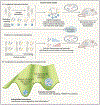Pursuing Human-Relevant Gut Microbiota-Immune Interactions
- PMID: 31433970
- PMCID: PMC7205593
- DOI: 10.1016/j.immuni.2019.08.002
Pursuing Human-Relevant Gut Microbiota-Immune Interactions
Abstract
The gut microbiota is a complex and plastic network of diverse organisms intricately connected with human physiology. Recent advances in profiling approaches of both the microbiota and the immune system now enable a deeper exploration of immunity-microbiota connections. An important next step is to elucidate a human-relevant "map" of microbial-immune wiring while focusing on animal studies to probe a prioritized subset of interactions. Here, we provide an overview of this field's current status and discuss two approaches for establishing priorities for detailed investigation: (1) longitudinal intervention studies in humans probing the dynamics of both the microbiota and the immune system and (2) the study of traditional populations to assess lost features of human microbial identity whose absence may be contributing to the rise of immunological disorders. These human-centered approaches offer a judicious path forward to understand the impact of the microbiota in immune development and function.
Copyright © 2019 Elsevier Inc. All rights reserved.
Conflict of interest statement
Declaration of Interests:
The authors declare no conflicts of interest
Figures


References
-
- Ayeni FA, Biagi E, Rampelli S, Fiori J, Soverini M, Audu HJ, Cristino S, Caporali L, Schnorr SL, Carelli V, et al. (2018). Infant and Adult Gut Microbiome and Metabolome in Rural Bassa and Urban Settlers from Nigeria. Cell Rep 23, 3056–3067. - PubMed
-
- Bach JF (2002). The effect of infections on susceptibility to autoimmune and allergic diseases. N Engl J Med 347, 911–920. - PubMed

